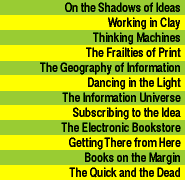


The Electronic Bookstore
Paper publishing is risky business. The economics of printing forces publishers to produce titles in large printings. Because per-copy costs drop sharply with volume, small print runs are not profitable. Large print runs, however, mean that more capital is tied up in paper for as long as the copies take to sell---if they ever do. So less capital is available to buy new titles or to promote current ones. In the meantime, the costs of warehousing, security, and insurance pile up.Even when publishers predict demand accurately, printing alone adds four to six weeks to delivery time and mailing adds a further two to three weeks. Even if warehousing and capital costs were zero, storage would remain a problem, for paper can't be kept waiting indefinitely because it decays in a few years. Besides, since paper books can't update themselves, they and their dated information are soon obsolete.
Because of those constraints, publishing today proceeds by guess and by gosh. Many more books are published than there is retail space for, and few of us buy books anyway. So a publisher lets retailers return unsold copies to increase the chances that they can afford to carry new titles. Occasionally as much as half of a mass market fiction print run of half a million copies is returned and destroyed. With the ever-rising tide of new books, the average newsstand display time for a title is now around a month. Books are, in effect, becoming magazines.
With electronic distribution, however, retail outlets won't have to keep as many copies of each title on hand as they think they can sell. They will need only one. Printing copies in the store or delivering them over the telephone will dramatically increase the diversity of titles that booksellers can offer.
For publishers, going to electronic books could mean no printing and its costly consequences: warehousing, transportation, delay, backordering, remaindering or destroying unsold books, and losing business. Instead of killing trees, expending oil and human labor to transport books, and polluting the environment, publishers could send any book on demand directly to any reader in the world in minutes. The same system would work for any other form of information---movies, software, designs, music, pictures, and television or radio shows.
By century's end, a few bookstores may devote half their space to books on computer disks, thereby at least quadrupling the number of titles they can carry but otherwise keeping many of the problems of paper publishing. Retailers will still have to order as many copies of each title as they think they can sell. But by early in the next century, some bookstores may become wall-sized, touch-sensitive display screens electronically displaying an array of titles, along with pictures and commentary. Perhaps each title will have its own book-sized rectangle on the display. Customers buying copies would read them on their own portable book readers.
Book chains would love such displays. They would have low rents, low insurance costs, no staff, no stock, no warehousing, no transportation, no remainders, no returns, no overhead, no reshelving costs, no replacement costs, no shoplifting, and no health care or workers' compensation expenses. The display would be easy to reorganize and could operate twenty-four hours a day. Finally, it could be placed at bus stops; in laundromats or church yards; or on playgrounds, buses, trains, ships, and even planes.
When books are electronic, we will have instant and unsleeping access to them---no more worrying that the library or bookstore isn't open late. Also, we'll have instant updates and revisions based on the latest information and electronic contact with all other readers of each book, thereby sharing ideas and reactions more rapidly and with more people.
Electronic books need never go out of print, and they'll be cheaper and far less bulky than paper books. Already we can store thousands of books on one small, lightweight computer disk at less than a cent a book. That price will continue to halve every two years. Paper simply can't compete.
Electronic libraries won't need big and expensive stores of decaying paper; so they will be able to shrink from warehouses to rooms and, one day, to a single telephone or cable television line. All catalogs will be electronic---as many already are---making them easier, faster, and cheaper to search, produce, and update. They could make it easier for libraries to refer readers to other books on similar subjects, tastes, or interests.
Libraries won't need to rebind old books or buy multiple book copies to allow for scuffing, mutilation, and destruction. Binding magazines into volumes, reshelving books, and reserving and otherwise restricting access to them will be things of the past. Librarians will no longer live in mortal terror of fire and flood. They won't need to chemically treat their decaying books, microfilm them, or transcribe them by hand to Braille, big-print, or audio formats. Currently, the U.S. Library of Congress can afford to transcribe only two thousand new books and one thousand new periodicals a year. Out of its twenty-five million books, it carries only thirty thousand in alternative formats.
Of course, some of us will always dislike having to read books on a screen. But once a book exists in electronic form, it is easy to print it out on paper. Besides, display technology will surely continue to improve so that in a decade it will be nearly as good as paper. A decade after that, it will be better.
Even if paper books persist, their appeal will fade. As electronic books quickly outgrow the restrictive linear text-and-pictures format, readers will experience paper books as flat, lifeless versions of what are now, essentially, living books. Going electronic is the future of books.